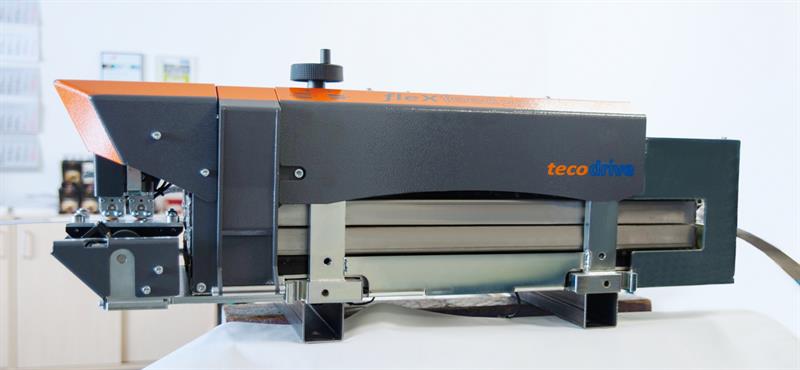The fleXfeed is well suited to sheet metal processing. Lighting experts, TriluX punch reflector plates for high-end lighting systems out of thin aluminium. Previously, the punch worked with a conventional feed roller at a rate of 200 strokes per minute. A higher cycle rate was not possible. The limiting factor was not the punch itself, rather it was due to "the feed roller limiting productivity", as Dr Olaf Marthiens, managing partner at tecodrive, explained.
The "speed limit" associated with feed roller applications can be explained in terms of physical causes, particularly mass inertia and the coefficient of friction between the strip and the rollers. The contact-free technology conveys material into systems smoothly and at high speeds, without any transverse forces or kinks forming in the strip. Using the fleXfeed, TriluX claims it has doubled its production rate and is now able to exploit the full potential of its sheet metal processing machines.
Together with Kollmorgen, tecodrive implemented a new type of control in the servo inverters, an alternative to field-oriented vector control (FOC). Using FOC would not work for this specific application, because the constantly changing magnetic behaviour of the material being transported would make the control circuit unstable. This problem was solved by only having one current and position controller in this particular application. FOC no longer applies, because Kollmorgen’s S772 servo inverter is programmed to specify and fix the field.
In order to determine the position of the sheet metal, tecodrive uses measuring wheels for feedback purposes. What's notable is the speed of the control circuit, because tecodrive calculates the next set point directly from the position of the sheet metal within the magnetic field, not via a control system or the field bus.
"We need there to be no delay whatsoever in order to ensure that positioning is accurate to 10µm, even at a cycle rate of 4000 strokes a minute. The peak values can be attributed to the computing power of the S700 drives and their streamlined and uncomplicated programming,” Dr Marthiens explained.
Tecodrive and Kollmorgen have devised a feed method that achieves the kinds of figures that, they claim, would not be possible with rollers. There is no mass with this feed method, because of the magnetic field. As a result, the process is reduced to switching the current on and off, with mass playing no part. This principle delivers other benefits including silent switching and no mechanical stresses, extending the service life of the equipment by reducing wear and tear.
Another key aspect is that the fleXfeed only needs a fraction of the energy used by a feed roller. "Although we need to use a Kollmorgen 35kW servo drive to achieve the necessary magnetising current, the effective power alone amounts to a mere 700W," said Dr Marthiens.
"At TriluX, we managed to combine two systems into one. We did this without compromising productivity, and still managed to save lots of space and greatly reduce tool costs," added Hans-Jörg Lindner, managing partner at tecodrive. For him, these are further benefits that make the case for abandoning the old methods of feeding materials.




